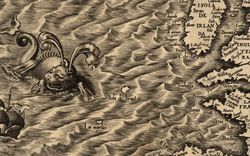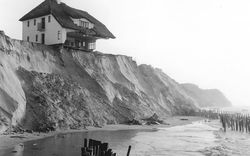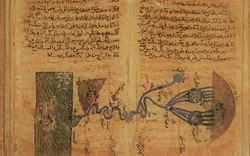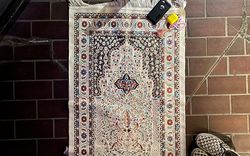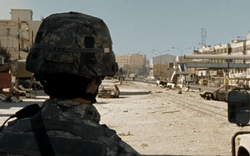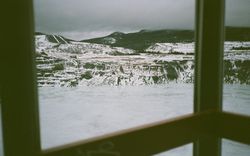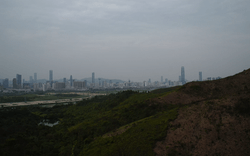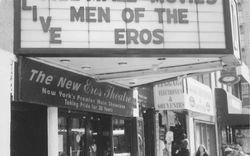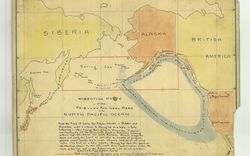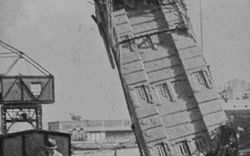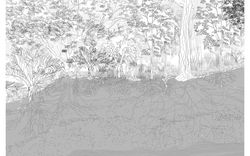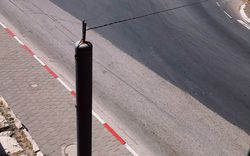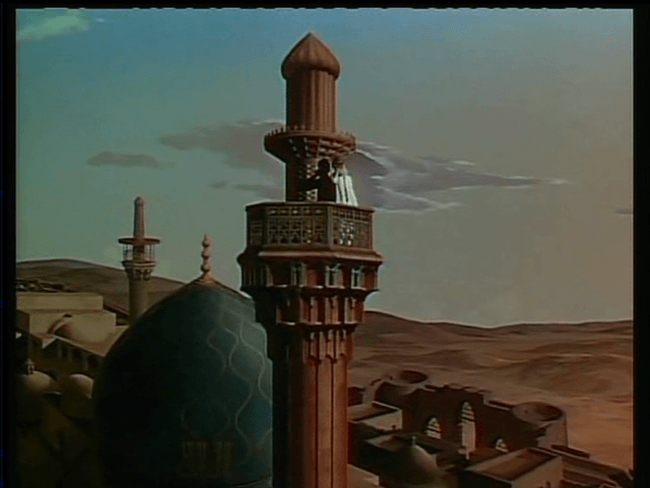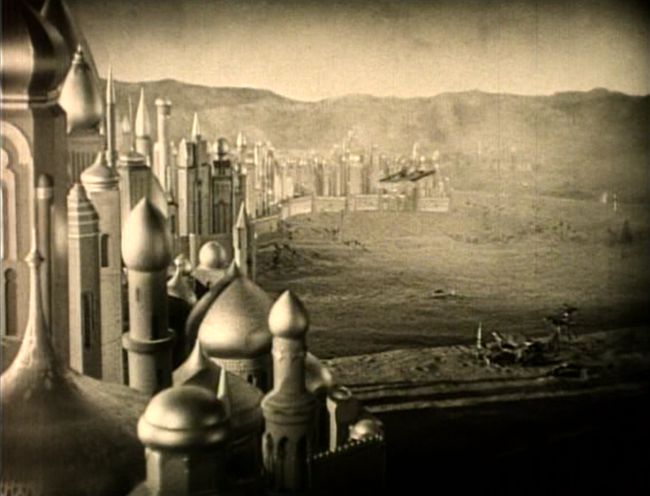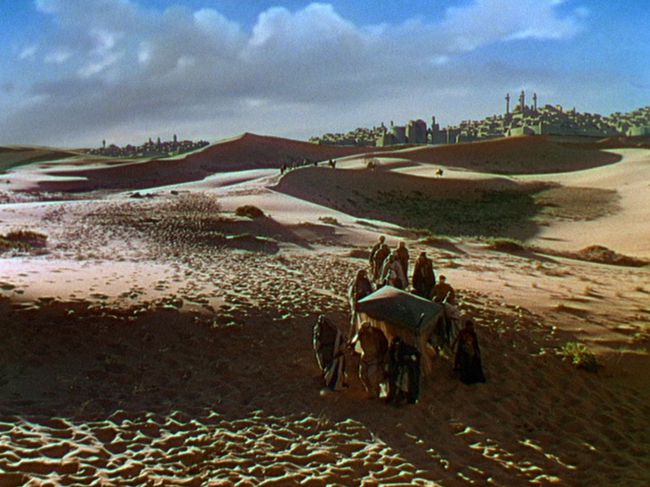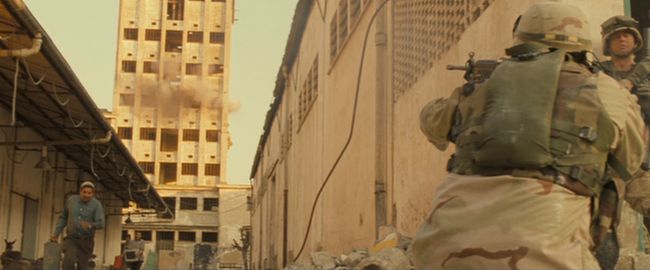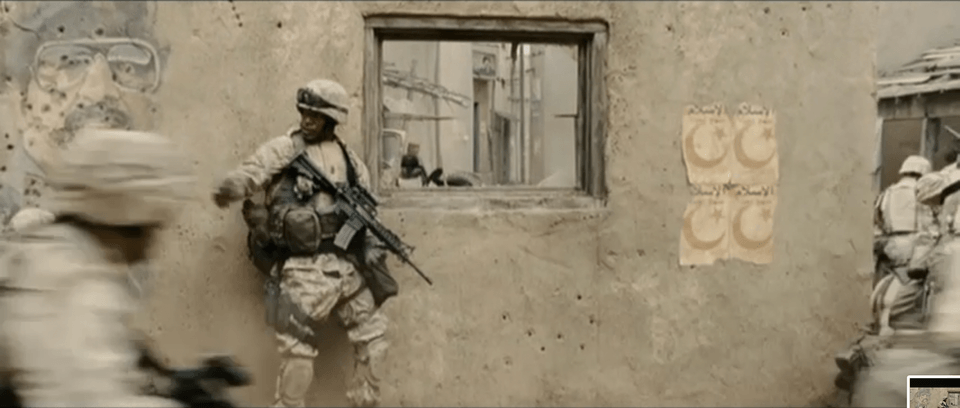Occluding Baghdad
Amin Alsaden on the violence inflicted by depictions of the city in Western films
On a trip to Baghdad in the 1950s, some British travellers were impressed by just one building. This dazzling shrine stood at the centre of an older part of town, its golden domes and minarets glistening in sharp contrast with the humble vernacular architecture surrounding it. In their published observations, the visitors made specific mention of the area, the “picturesque” northern suburb of Kadhimain, recognizing it as “about the only part of Bagdad [sic] which at all resembles the city against whose background Marlene Dietrich has so often acted.”1 The movie star had appeared in the 1944 film Kismet, inspired by the Arabian Nights.
The impact of Western films such as Kismet on rendering Baghdad for global audiences was profound, even influencing actual encounters with the city. Because of the British mandate that effectively colonized Iraq from 1917 to 1958, and due as well to Iraq’s chronically troubled post-independence decades, Baghdad remained largely inaccessible to foreigners through much of the twentieth century. These British travellers, therefore, were rather an exception.2 Many could not experience firsthand—and thus accurately portray—the reality of this territory. As a result, global perceptions of Baghdad have been predominantly shaped by constructed narratives—stories circulated and embraced primarily in the West, without much verification or friction—and rarely informed by the city’s physical form or the accounts of its inhabitants.
For those who did manage to visit, Baghdad was usually a disappointment: conditioned by cinematic depictions, visitors saw a notable discrepancy between the fictional versions of the Baghdad they came to know at home and the real city. Indeed, the on-screen Baghdad, which can be taken as an extreme case study, standing in for representations of other parts of Southwest Asia (or the “Middle East,” a region at the intersection of the Arab and Muslim worlds), has, for much of the modern period, been systematically constructed in the collective global imaginary through mediated and invented narratives. I would argue that such depictions have served to reify colonial and neoliberal perceptions of this geography through fabulations that sanction and facilitate imperial exploits.
In the early history of film, the real Baghdad was buried under the heavy weight of narratives propelled by what appears to be a benign exoticism, the gaze of which channelled the eternally picturesque, opulent, and decadent home of Aladdin. Unapologetically outlandish representations positioned the city as a spectacle, an overload of hallucinatory imagery, feeding the popular appetite for the tantalizing excesses associated in the Western imagination with the Arabian Nights. This clearly built on previous representations, in literature and print media, for example, but the rise of film as the most popular means of storytelling coincided with the period during which Baghdad was largely inaccessible. Indeed, perhaps more than any other medium, it was film that helped entrench the notion that Baghdad was the locus of the intriguing, and equally menacing, “Orient.”
Often the focal point (or at least a frequent referent) in an alternative, enchanting, dreamlike world, Baghdad is, in many early- and mid-twentieth-century films, a place where logic is suspended and a delightful chaos rules. “Baghdad,” an eponymous 1949 film’s narration affirms, is “Sheherezad’s fabulous city of the Thousand and One Nights.” The camera, meanwhile, pans across the film set, showing a model of a putatively archetypal Oriental town moored to an undulating landscape, replete with domes and minarets above an otherwise jumbled urban form. Rolling, enormous desert dunes are visible in the distance. In this and other films, Baghdad is presented as a Casbah-like, Sahara hill town despite the fact that the real city is located in a flat, fertile landscape. “For five thousand years,” the voice-over continues, “a fortress in the desert, crossroad between civilized West and savage East.”1
Some of the earliest releases asserted this purported link between Baghdad and the Orient. Expository intertitles in silent films declared: “Bagdad [sic] the Beautiful—Jewel of the Orient” or “Bagdad, dream city of the ancient East.”2 While it was Western fascination with the Orient that gave credence to Baghdad, the reverse was also true: the fictitious Baghdad gave shape to the mercurial notion of the Orient. Baghdad and the Orient, that is, were mutually co-constitutive.
-
Bagdad, 1949, directed by Charles Lamont, California: Universal International Pictures, DVD. ↩
-
The quotations are from intertitles of the films: The Thief of Bagdad an Arabian Nights Fantasy, 1924, directed by Raoul Walsh, New York: Kino on Video, 2004, DVD; and Kismet an Arabian Night Fantasy,1920, directed by Louis J. Gasnier, Phoenix, Arizona: Grapevine Video, 2011, DVD. ↩
The architectural attributes of these on-screen Baghdads varied widely: some seemed to be based on real precedents from iconic cities in the Arab and Muslim worlds while others were figments of their creators’ wild imaginations. One of the most bizarre concoctions could be seen in the 1924 film The Thief of Bagdad, in which an aerial shot reveals a city with such a dense accumulation of onion-shaped domes and matching minarets that the viewer is left with the distinct impression that this was the only typology in the city.1 These elements were presumably chosen to underscore the Muslim otherness of the Orient, amplifying what was most different in the urban form of that culture. Several films, including 1942’s Arabian Nights, situated Baghdad as a remote outpost in a vast desert, protected by high walls, with its buildings almost erupting out of a mystical enclave. Baghdad was seen by audiences as a faraway and curious spatial entity, one embedded in and defined by an inhospitable landscape.
In the twenty-first century, these earlier depictions, perhaps motivated by an Orientalist curiosity about the “other,” gave way to more militant portrayals of Baghdad. The city, still obscured in present-day representations, is now vilified in war films as the “hostile territory,” the breeding ground for what viewers are led to believe is the ultimate threat to Western democracy, in the guise of so-called insurgents and terrorists who emerge from its post-apocalyptic urban ruins. This stark shift was brought about by the 1991 Gulf War and was heightened dramatically following September 11, a watershed moment for the demonization of Muslims en masse, and then the 2003 American invasion of Iraq.
So, in recent films Baghdad became the prototypical battleground. The contemporary city is now staged as any generic, conflict-wrecked, or rundown modern city in the Muslim and Arab worlds. Curiously, it was perhaps Disney’s popular animated film Aladdin, released in 1992, that first marked this transition. The Gulf War prompted the filmmakers to change the animation’s setting from Baghdad to a fabricated, Oriental-sounding town they called “Agrabah” (almost an anagram of Baghdad), in order to avoid any unsavory associations between the city then being ruthlessly bombed and the locus of the entertaining story produced in the same country leading the attack.2
From there, however, the bombing of Baghdad became the most common trope. In the acclaimed 2008 war film The Hurt Locker, one of countless features generated by America’s endless military adventures in Iraq, the tense scenes revolve around a US Army explosives-diffusion unit carrying out its mission in what is presumably today’s Baghdad. The suspense is palpable, and although the villains are meant to be guerrilla fighters targeting invading American soldiers, the terrifying streets of Baghdad are in fact the main antagonists. And that is carefully orchestrated: the dusty, desolate roads; burnt-out cars; poor, crumbling, and low urban form; abandoned infrastructure, like train tracks, bewilderingly set in residential neighborhoods; signs in Arabic fading in the harsh sunlight; goats feeding on trash strategically strewn in front of the camera; and, of course, the obligatory domes and minarets. The danger in this film stems not only from snipers, improvised explosive devices, or even those inscrutable locals whose gibberish words we cannot understand and whose brown faces we cannot read, but from the city itself, with its perplexingly rugged terrain, half-desert, half-ghetto, where relatable human beings could not possibly live, only the brutish natives the benevolent American forces are meant to liberate and democratize. This supposedly authentic Baghdadi landscape—backdropped, puzzlingly, by undulating hills—was actually shot in Jordan, though Morocco and Kuwait were also considered.3
In the 2010 action film Green Zone, too, Baghdad is shot elsewhere, in this instance in different locations in Morocco.4 While not as consistent or monolithic as the Baghdads seen in other films, in Green Zone the city is signalled by telling vignettes, all unified with a golden sun and ochre dust: the wasteland, full of dilapidated infrastructure; the disarray of a dense city with an incomprehensible tangle of traffic and mad pedestrians; and the bullet-ridden concrete jungle, where brave American forces fight “extremists” inexplicably resisting a foreign invasion of their land.
-
The Thief of Bagdad an Arabian Nights Fantasy, 1924, directed by Raoul Walsh, New York: Kino on Video, 2004, DVD. ↩
-
This has been confirmed by the film directors Ron Clements and John Musker, who have stated that the story was indeed originally set in Baghdad, until the first Gulf War, when Roy Disney objected that the film could not be set in that city. So, Musker “took letters and did a jumbled anagram and came up with Agrabah [Aladdin’s city in the film].” See: Zach Johnson, “Disney Myths Debunked by Ron Clements and John Musker, Directors of The Little Mermaid, Aladdin and Hercules,” E! News, 15 October 2015, accessed 26 March 2022, http://www.eonline.com/uk/news/706239/disney-myths-debunked-by-ron-clements-and-john-musker-directors-of-the-little-mermaid-aladdin-and-hercules. ↩
-
On the making of the film, see: Borys Kit, “‘Locker’ lands 3 in Iraq story,” The Hollywood Reporter, 17 July 2007, accessed 26 March 2022, https://www.hollywoodreporter.com/business/business-news/locker-lands-3-iraq-story-143373/; Glenn Whipp, “Kathryn Bigelow and the making of ‘The Hurt Locker’,” Los Angeles Times, 23 December 2009, accessed 26 March 2022, https://www.latimes.com/archives/la-xpm-2009-dec-23-la-en-bigelow23-2009dec23-story.html; and Nick Dawson, “Time’s Up: Kathryn Bigelow’s The Hurt Locker,” Filmmaker, 5 March 2010, accessed 26 March 2022, https://filmmakermagazine.com/4686-times-up-kathryn-bigelows-the-hurt-locker-by-nick-dawson/#.Yj8045rMKWA. ↩
-
“Green Zone | 2010,” The Worldwide Guide to Movie Locations, accessed 27 March 2022, http://movie-locations.com/movies/g/Green-Zone.php#:~:text=Most%20of%20Green%20Zone’s,of%20the%20Bou%20Regreg%20river. ↩
One should not necessarily expect nuance or sensitivity in representations of Baghdad from American blockbusters sympathetically channeling the points of view of American soldiers. But for such films to collapse the diverse places of a vast region into each other and to present them as though interchangeable is itself astounding. Still, these films’ conflation of the contemporary cities of this part of the world, and use of them as substitutes for a fictional Baghdad is instructive and speaks of obvious similarities: the precarious architecture and the ubiquitous state of decay and disrepair, for instance, which attests to the devastating legacies of colonialism, the ravages of frequent military interventions, and the support of despotic regimes that have long safeguarded Western interests in the region. Paradoxically, these similarities are amplified in war films, in which the heterogeneity of cities in these geographies is eschewed for stereotypical cinematic depictions of places deemed too risky to film in yet with stories too important to ignore.
The 2005 film Jarhead epitomizes recent representations of Baghdad and other troubled parts of this region. The film actually revolves around the Gulf War, so most of it is set in a desert landscape, at the border between Iraq and Kuwait. (Baghdad was pounded from above in 1991, with several other air strikes that decade, but the allied forces’ ground troops did not make it to the city prior to 2003). Aside from the manner in which the desert is depicted as an alien terrain where American wars are fought—replacing the trope of the tropical jungle in numerous Vietnam war films—it is a scene toward the end of Jarhead that is remarkable in the economy in which it portrays what seems like Baghdad. In a flash-forward to the 2003 invasion of Iraq, the character played by Jamie Foxx—a US Army staff sergeant who proclaims his love for war earlier in the film—is shown in combat, the implication being that he is leading troops into Baghdad. Captured fleetingly, the city is represented by an urban fragment: beige, crumbling, bullet-riddled walls with murals of Saddam Hussein, withered posters with crescents—which curiously, and with admirable Hollywood efficiency, simply spell out the word “Islam” in Arabic—and a burnt-out military vehicle. There is, in fact, something eerily familiar about the set, and not just because it feels so common from recent war films: by removing the American soldiers, vehicle, and contemporary imagery, one could easily imagine the exact same set used as the backdrop for a typical market scene in an Orientalist period film.
It is not surprising that the earlier representational tendency was rampant when Iraq was under British control, while the latter tendency escalated after the American and allied attacks on Iraq, culminating in the occupation of the country—one of the most brazen forms of neo-colonialism in recent history. These representational entanglements, rooted in Orientalism during the modern period and Islamophobia today, are integral to the kinds of narratives disseminated about this part of the world, aiding political meddling, “improvement” schemes, and ultimately enabling dominance over its lands and oil. (This region remains vital for the insatiable global demand for fossil fuels, and the 2003 invasion of Iraq cannot be understood without accounting for American energy needs). The exact same narratives that guarantee the continued supremacy and secure the stability of the West are often spun at the expense of the rest of the world’s right to narrate from its own point of view.
Edward Said once wrote: “The power to narrate, or to block other narratives from forming and emerging, is very important to culture and imperialism, and constitutes one of the main connections between them,” and, he elaborated, it determines how land is represented, and thus controlled, under the colonial enterprise.1 This is not to suggest that these films were produced deliberately as propaganda—but that they are, like the seminal works of modern fiction Said examined, produced under empire, and they contribute to spreading certain narratives developed in the centre about “others” at the margins, while, surreptitiously and unwittingly, suppressing more nuanced or defiant narratives. War is not only waged through deadly weapons; its arsenal is also discursive, abetting an imperceptible ideological and cultural offensive that includes discriminatory exclusions, selective affinities, and prescribed representations.
-
Edward W. Said, Culture and Imperialism (New York: Knopf, 1993), xiii. ↩
The films discussed here, mostly produced in the US, are certainly not the only representations of Baghdad. Like all great cities, Baghdad has inspired numerous attempts at expressing what this culturally rich, historically significant, and ever evolving urban centre means for different people, locals and foreigners alike. However, these are the main representations of Baghdad by the West, and together they say more about the West than about the city itself, or the region more broadly. Indeed, the Baghdad seen in film usually has nothing to do with the actual city, but is contrived out of phantasmagoric versions of it, lodged deep into the psyche of Western imagination.
In these few paragraphs, there is no attempt at exploring or revealing the other Baghdads—in their plural, real or imagined forms—obfuscated by these representations (an especially difficult task for those of us who have lived experience in the city and who are familiar with its complexity.) This is also not the place to dismantle or rewrite the understandings of this territory. This essay is simply meant as a brief survey of a handful of examples of two key insidious representational tendencies—perhaps barely scratching the surface—to highlight how the city is relentlessly occluded by a steady flow of manufactured images that circulate globally, often accepted because of their frequency and persistence as accurate depictions of Baghdad’s reality.
By coming to terms with how knowledge about a territory is produced through dominant narratives created by those whose worldviews are coloured by imperial powers, one might get closer to confronting the fact that a pattern of misguided representations is yet another form of organized violence—more subtle yet no less brutal—inflicted on this geography and its peoples. The violence wrought by these films equally extends to Baghdad’s diasporic communities globally, many of whom had to flee their war-torn city, subjecting them to the cruelty of reductive and deceptive representations that gradually cloud the sense of place that live on primarily in elusive, precious memories.


